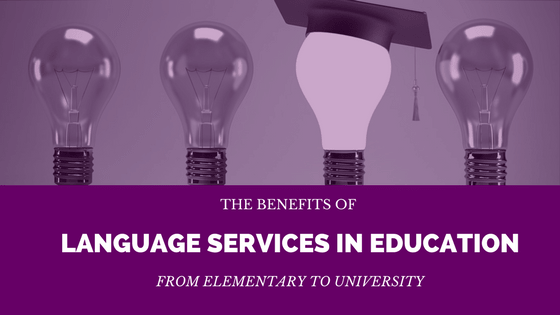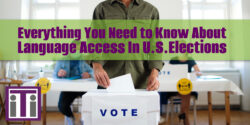
Approximately five million students in US schools have Limited English Proficiency, which is defined by the U.S. Census Bureau as anyone age five or older who speaks English less than “very well.” Title VI of the Civil Rights Act of 1964 prohibits discrimination on the basis of race, color or national origin in the operation of any federally assisted programs. Under this law, it is the responsibility of the schools to ensure that all students have equal access to a quality education that enables them to progress academically while learning English. The law is designed to promote inclusivity and underscores the enormous importance of language in education.
Federal law is violated if:
- Students are excluded from effective participation in school because of their inability to speak and understand the language of instruction;
- National origin minority students are inappropriately assigned to special education classes because of their lack of English skills;
- Programs for students whose English is less than proficient are not designed to teach them English as soon as possible, or if these programs operate as a dead-end track; or
- Parents whose English is limited do not receive school notices or other information in a language they can understand.
So, how can schools best address the increasing education gap and support their diverse student bodies? The suggestions below are opportunities to create internal support within each school system.
Educate staff on multiculturalism

While it seems simple and obvious, educating staff on how to work with students of different cultures and backgrounds is extremely effective. The better the educators understand their students, the better they can serve them in and out of the classroom with help, encouragement, and support. Ines Marquez Chisholm writes in a report titled Preparing Teachers for Multicultural Classrooms:
“Cultural diversity poses a pedagogical and social challenge to educators. Teaching effectively in culturally diverse classrooms means using culturally sensitive strategies and content to ensure equitable opportunities for academic success, personal development, and individual fulfillment for all students. Teachers need to be, “knowledgeable about how minority children perceive the world, and process and organize information. Culture and gender influence not only our values, beliefs, and social interactions, but also how we view the world, what we consider important, what we attend to, and how we learn and interpret information. Furthermore, the effect of ethnicity on cognitive and motivational styles within an ethnic group persists across social-class segments.”
Establish procedures for staff
In conjunction with educating staff on multiculturalism, it is important to have reference documents available outlining the federal requirements, procedures, language service options, etc. Two great examples of this are:
- Refugee Children in U.S. Schools: A Toolkit for Teachers and School Personnel
This booklet is a great example of a resource for school systems. This was created by an organization called Bridging Refugee Youth & Children’s Services supported by the U.S. Department of Health and Human Services. School systems do not necessarily have to create everything on their own, there are already plenty of resources available to share with their staff. - Providing Language Access Services for Limited English Proficient Parents in Washington Schools
This extensive report outlines a wide range of material varying from defining language access services to demographics of local areas to feedback from parent groups and of course requesting language services for schools.
Hire bilingual staff
Hiring new staff who speak languages that are in need is a great option for school districts and universities. Having bilingual staff available is very beneficial to both students, parents, and other teachers/staff that may be working with the students.
A few years ago, Buffalo Public Schools began offering services in 85 different languages for immigrants and refugees who enroll in school by hiring multilingual staff. One major thing to keep in mind when hiring staff because they speak multiple languages is their proficiency in said language. Just because a person says they speak Spanish, for example, doesn’t mean they have full professional proficiency in Spanish. Consider how they may be interacting with students and family and what level of proficiency may be necessary.
What can you do when hiring bilingual staff just isn’t feasible? Bring in the support of a third-party vendor who provides professional language services.
Most language service providers offer solutions specifically for educational institutions. Below is a brief overview of the most common services used throughout schools and universities.

In-Person Interpreting
In-person interpreters are scheduled in advance for meetings, parent-teacher conferences, evaluations, graduations, etc. In-person interpreting is available for spoken languages as well as American Sign Language for deaf or hard-of-hearing students. Each language service company may have different language options so be sure to request a full language list before deciding to work with a company. Reputable companies will work with high-quality interpreters who are experienced working with children, parents, and in an education setting.
Remote Interpreting Options
There are some situations where an in-person interpreter is not necessary or an emergency situation where there is no time to find one. In these instances, over-the-phone interpreting and/or video remote interpreting can help to save the day.
Over-the-phone interpreting gives you access to interpreters over the phone 24/7/365. Most services available offer you a standard 800 number with an access code that will give you access to hundreds of languages in seconds.
Video Remote Interpreting (VRI) is similar to a Skype call but over an encrypted platform that connects you to qualified professional interpreters. VRI is especially useful for deaf or hard-of-hearing students as the visual aspect gives access to ASL interpreters within minutes.
Most organizations choose to use a combination of services for the different situations that arise. Each language services company you approach most likely has a slightly different way of doing things so be sure to ask a lot of questions!
CART / C-Print
CART stands for Communication Access Real-time Translation and is an extremely beneficial innovation for the deaf or hard-of-hearing community in school. CART is most easily described as subtitles for live discussions. Spoken language is translated instantaneously into text and displayed in various forms such as on a computer. A CART writer can either sit in the classroom with the student or work remotely via a high-powered microphone strategically placed in the classroom. While CART is an exact transcription of the entire class word for word, C-Print summarizes the conversation or lecture. It’s similar to an electronic note-taking system designed to provide a meaning for meaning transcription.
Document Translation
While interpreting and CART work with the spoken word, translation encompasses the written word. In terms of education, this is beneficial for letters to parents, emails, tests/quizzes, brochures, forms, and any legal documents. It is wise to always use a professional agency to translate any type of document to ensure accuracy. There is no room for error when sending home legal documents in multiple languages. Here is how to choose the best translation agency.
Clearly, the importance of language in education can’t be overstated. What do you think is the most important thing for educators to keep in mind when working with a diverse group? How can we continue to improve the quality of our education system with an increasingly growing population of non-English speakers? Please let us know in the comment section below!
Want more information on how to attract more international students? Download our free guide on “how to create an all-inclusive scholastic experience for international students” today!
Sources
National Clearinghouse for English Language Acquisition
This blog was updated on 9/27/21






Comments are closed here.